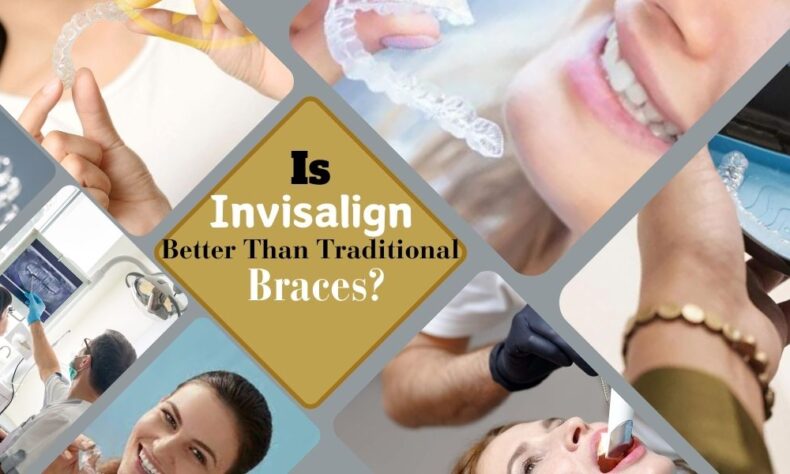
If you’re considering straightening your teeth, you’re probably weighing up traditional braces versus Invisalign. Both can give great results, but is one better than the other? Here’s an overview of how Invisalign and braces in London compare, so you can decide which is best for your smile.
What is Invisalign?
Invisalign consists of a series of clear, custom-made aligners that you change approximately every 1-2 weeks. Each set of aligners applies light forces to gradually shift your teeth into place based on a pre-determined treatment plan. Unlike braces, aligners are removable so you can eat, brush and floss normally.
Invisalign aligners are virtually invisible when worn, making them an appealing choice for teenagers and adults who want to straighten their teeth discreetly. The aligners are also more comfortable than braces as there is no metal wiring or brackets rubbing inside your mouth.
What Are The Pros of Invisalign?
Invisalign has several advantages over traditional wired braces:
Aesthetics – Invisalign aligners are practically invisible, whereas braces are highly visible. This makes Invisalign an excellent choice if you’re conscious about your appearance during treatment.
Removability – You can remove Invisalign to eat, drink, brush and floss as normal. This helps maintain good oral hygiene.
Comfort – Without metal wires and brackets, Invisalign tends to be more comfortable than braces. There’s also less chance of mouth abrasions or sores.
Shorter treatment times – The average Invisalign treatment is 12-18 months. Simpler cases can be as short as 6 months.
Fewer restrictions – You can enjoy foods like popcorn or sticky candy without damage to aligners or wires. Normal limitations still apply though – chewy and crunchy foods aren’t recommended as they can distort aligners over time.
What About Braces?
Traditional braces remain a tried-and-tested solution for achieving straighter teeth and a properly aligned bite. Your orthodontist bonds small brackets onto each tooth, joined together by a wire that applies gradual pressure to shift teeth into their ideal positions over time. While dental braces may not have the advantages of invisibility or removability like Invisalign offers, they remain an effective treatment option. Here’s an overview:
The Pros
- Proven results over decades of use for a wide scope of cases – from minor to complex
- Often covered by dental insurance, making braces a cheaper upfront option than Invisalign for many people
- Fixed 24/7, enabling teeth to move more quickly into place
- Succeed in addressing complex cases that require precise tooth movements – e.g closing gaps or alignment issues
The Cons
- Less aesthetic as braces are highly visible
- Can be uncomfortable initially – brackets and wires may irritate mouth
- Oral hygiene requires more effort as braces can’t be removed
- Dietary restrictions apply to protect braces from damage
- Regular adjustments needed through longer average treatment times (18-24 months)
Which Is More Effective – Invisalign or Braces?
Both braces and Invisalign can effectively and safely straighten teeth for most people. But which delivers better results?
Research suggests Invisalign and braces produce similar outcomes for mild to moderate alignment issues. However, braces remain the best choice for complex cases requiring coordinated movements across several teeth – e.g. aligning a very uneven bite.
Other factors impact effectiveness, including:
Case complexity – only mild to moderate cases qualify for Invisalign
Compliance with treatment – Invisalign relies heavily on wearing aligners 20-22 hours daily
Teenagers often achieve faster progress with braces
Talk to an orthodontist before deciding if your case best suits Invisalign or braces. While both can produce outstanding improvements to your smile, an experienced dentist will assess oral health and alignment needs before recommending the best route.
How Much Does Invisalign Cost Compared to Braces?
On average, the cost of Invisalign ranges from £3,000–£8,000 USD compared to £3,000 – £6,000 for braces. Check your dental insurance though – orthodontic treatment often includes a generous coverage for braces for children and teens, making them the more budget-friendly option. Conversely for adults, the typical insurance coverage amounts to £1,000-£1,500 for Invisalign and £500 for braces.
Without insurance, Invisalign tends to cost more upfront. But advantages like faster average treatment times combined with flexibility and comfort make this premium clear aligner treatment a smart investment that pays dividends long-term.
Should I Choose Invisalign or Braces?
Deciding between braces or Invisalign aligners requires careful consideration of your lifestyle needs, budget, and most importantly – the orthodontic recommendations for your teeth. Both offer cosmetic and health benefits that boost confidence and improve dental function. Key is choosing what’s right for your unique smile goals and needs.
If you’re exploring teeth straightening options, an initial Invisalign braces consultation in London allows you to discuss choices suited to your smile. Here you can address important considerations like treatment times, effectiveness, costs and insurance coverage, to determine if clear aligners or traditional braces better fit your orthodontic needs.
Want to learn more about discrete teeth straightening with Invisalign? Contact and visit at our 1A Orthodontics in Wandsworth, London clinic today to book a no-obligation Invisalign assessment and see if it’s right for you!






